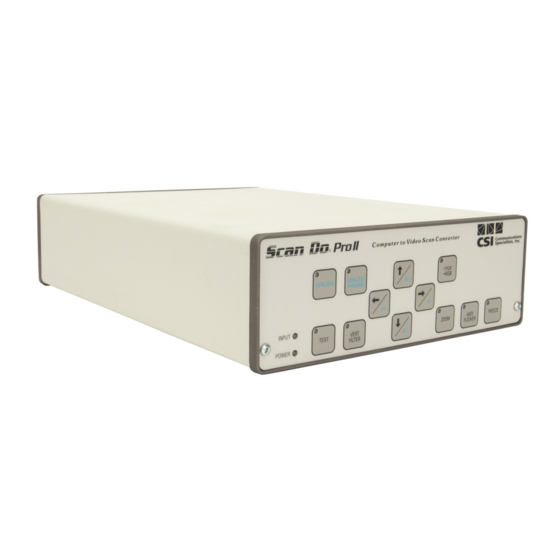Communications Specialties Scan Do Pro II Podręcznik użytkownika - Strona 9
Przeglądaj online lub pobierz pdf Podręcznik użytkownika dla Konwerter mediów Communications Specialties Scan Do Pro II. Communications Specialties Scan Do Pro II 15 stron. High resolution computer-to-video scan converter with genlock and optional sdi output (scan do pro ii/d)

KNOW WHAT YOUR CONVERTED
IMAGE WILL LOOK LIKE:
USE BLACK AND WHITE:
AVOID INTENSE COLORS:
TIPS FOR IMPROVING YOUR
CONVERTED COMPUTER IMAGES
I
t has been our experience, at CSI, that customers are sometimes
surprised that computer images converted to video do not look as
sharp and vivid as the original computer image does. Unfortunately,
this result is inevitable regardless of the scan converter you use, for the
technology behind TV video is far inferior to that behind newer computer
video standards. This is not to say that the quality of scan converter you
use doesn't matter, but even the very best scan converter will not provide
output that matches the quality of your original computer picture.
Scan converters, like Scan Do Pro II, were created to bridge the
differences between the relatively new standards of computer video and
the 40-year old standards of conventional TV video. When using a scan
converter, there are several things you can do to get the best possible
results from the conversion process. These involve understanding the
limitations of standard TV video and creating images that "work around"
these shortcomings. The following tips apply whether you are displaying
your scan converter output directly on a monitor or recording it onto
videotape. While you should have realistic expectations regarding the
type of image you will be able to obtain, taking the following steps will
definitely improve your results:
First of all, when creating any computer presentation that you ulti-
mately plan to display in video format, it is always a good idea to hook
up a Scan Do Pro II and view the output on a TV monitor during the
creation process. While this may require a little bit of extra set-up time,
it has the potential to save you far more time and aggrevation later on by
avoiding the need to correct any unwanted "surprises" in your finished
work.
In the world of standard TV video, shades of gray are processed
differently than colors. In fact, TVs and VCRs process black, white and
all grays in between with a minimum of distortion. Use this to your
advantage in the design process by substituting gray in place of color
whenever appropriate.
Along the same lines, fully saturated colors (like bright red and green)
look terrible on a TV monitor. And, recording these colors to videotape
makes them look even worse. Whenever possible, try to use slightly
muted colors instead.
Scan Do Pro II User's Manual
Page 9
